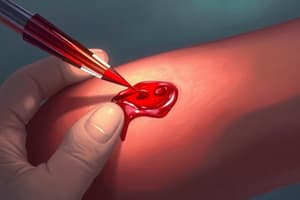Podcast
Questions and Answers
What is the composition of capillary specimens?
What is the composition of capillary specimens?
- A mixture of arterial blood and interstitial fluid
- A mixture of arterial, venous, and capillary blood (correct)
- A mixture of arterial and venous blood
- A mixture of venous blood and intracellular fluid
When is capillary puncture an appropriate method for adults and older children?
When is capillary puncture an appropriate method for adults and older children?
- When the patient is undergoing surgery
- When the patient is taking anticoagulant medication
- When there are no accessible veins or available veins are fragile (correct)
- When the patient has a bleeding disorder
Why is capillary puncture the preferred method for obtaining blood from infants and young children?
Why is capillary puncture the preferred method for obtaining blood from infants and young children?
- Because it reduces the risk of infection
- Because it is less painful
- Because it does not cause damage to veins and surrounding tissues (correct)
- Because it is less invasive
What is a reason why capillary blood is preferred for certain tests?
What is a reason why capillary blood is preferred for certain tests?
Why is capillary puncture a preferred method for patients with thrombotic or clot-forming tendencies?
Why is capillary puncture a preferred method for patients with thrombotic or clot-forming tendencies?
What is a common use of capillary blood in point-of-care testing (POCT)?
What is a common use of capillary blood in point-of-care testing (POCT)?
What is the recommended depth of incision for adults?
What is the recommended depth of incision for adults?
Why is it important to warm the site before collecting a blood sample?
Why is it important to warm the site before collecting a blood sample?
What is the primary purpose of using a gauze or gauze-type pad?
What is the primary purpose of using a gauze or gauze-type pad?
What is the recommended order of draw for capillary specimens?
What is the recommended order of draw for capillary specimens?
What is the maximum temperature of the water used for warming devices?
What is the maximum temperature of the water used for warming devices?
What should be done when venous blood is collected by syringe and put into microcollection containers?
What should be done when venous blood is collected by syringe and put into microcollection containers?
What is the primary reason for warming the site when collecting blood specimens?
What is the primary reason for warming the site when collecting blood specimens?
Why is the first drop of blood typically wiped away?
Why is the first drop of blood typically wiped away?
What is the term used to describe a specimen obtained from a warmed site?
What is the term used to describe a specimen obtained from a warmed site?
What is the proper procedure after puncturing the site?
What is the proper procedure after puncturing the site?
What is the primary purpose of microhematocrit tubes?
What is the primary purpose of microhematocrit tubes?
What should be done with the used and contaminated materials?
What should be done with the used and contaminated materials?
What is the final step in the procedure?
What is the final step in the procedure?
What is the purpose of sealants in microhematocrit tubes?
What is the purpose of sealants in microhematocrit tubes?
What is the recommended site for capillary puncture on adults and children older than 1 year?
What is the recommended site for capillary puncture on adults and children older than 1 year?
Why should capillary puncture not be performed on the fingers or earlobes of newborns or infants under 1 year of age?
Why should capillary puncture not be performed on the fingers or earlobes of newborns or infants under 1 year of age?
What is the purpose of warming the site before capillary puncture?
What is the purpose of warming the site before capillary puncture?
What is the difference between heparin and nonadditive microhematocrit tubes?
What is the difference between heparin and nonadditive microhematocrit tubes?
Flashcards are hidden until you start studying




